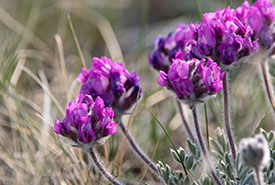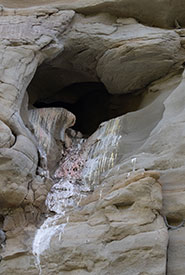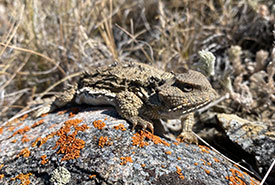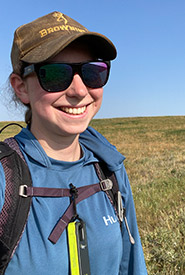NCC: Land Lines – How I spent my summer helping conserve species at risk in the Prairies

Hare-footed locoweed (Photo by Kayleigh Weaver/NCC staff)
This summer, I had the amazing opportunity to work with the Nature Conservancy of Canada (NCC) as a conservation intern in southern Alberta. I spent most of my time working in the Milk River Ridge Natural Area with my direct manager, but I also worked across southern Alberta with other NCC colleagues on their respective projects.
Some of the most rewarding work was learning how to search for species at risk living within our Prairie grasslands, which are considered one of the world’s most endangered ecosystems. During this work, I learned to appreciate these incredible species and the threatened habitats where they are found.
One of the first species at risk surveys was for a rare plant called hare-footed locoweed. It has narrow habitat requirements, so it grows in only a few places in Alberta. This low-growing, fuzzy-leaved flower prefers to grow on the top of slopes where there are well-drained, gravelly soils and less competition from tall grasses, such as rough fescue.
Seeing these rare plants left a mark on me. Simply put, this was one of the most beautiful flowers I had ever seen. Its purple and pink petals were so vibrant they were hard to miss while walking on the tops of the coulees. Despite this rare plant survey only taking a couple days, it was so much fun finding new locations of this beautiful, rare flower scattered across the Prairies.
I was also fortunate to participate in some wildlife surveys for different raptor species. This involved hiking up and down the coulees, which was strenuous, to say the least.

Prairie falcon nest (Photo by Kayleigh Weaver/NCC staff)
But to see these birds’ amazing nests (from a respectful distance) made the hard work worth it. To find each nest, we had to keep an eye out for signs, such as whitewash (bird poop) on the cliffsides and look for young birds in the nest.
We located active ferruginous hawk and prairie falcon nests. The prairie falcons nested in cliff cavities, while the ferruginous hawks nested on top of hoodoos or in trees.
Seeing so many different raptor species nesting across several NCC properties was heartwarming. That’s because I know these important habitats are being protected so these birds can raise their young — and boost their populations!
Of all the great experiences this summer, my favourite by far was searching for greater short-horned lizards, Alberta’s only lizard species!
Finding these lizards wasn’t easy! Sun shirts, many litres of water and a great hat were musts on this survey day since the temperatures reach 35 C by noon in sunny July in the badlands.

Greater short-horned lizard (Photo by Kayleigh Weaver/NCC staff)
It also took sharp eyes and patience. These lizards grow no larger than the size of your palm. As ambush predators, they also have amazing camouflage and can remain very still. These traits help them hunt ants, but it makes them difficult to spot.
Despite the heat and the many hours of slow hiking through the badlands, we were able to find greater short-horned lizards at different life stages. We found juveniles born this year, an adult male and adult female. This shows that this NCC property has suitable breeding and foraging habitat for this endangered species.
Being able to work with NCC this summer has been one of the best experiences I have had! The opportunity to learn about species at risk first-hand, and to help while in the office and field gives me the reassurance that I and my NCC colleagues are contributing to grassland conservation and the protection of important habitat that many species at risk call home.
If you would like to support the conservation of our grassland wildlife, visit conservemcintyreranch.ca.
All surveys were done with proper permits and following provincial protocols. Intern funding was provided by Canada Summer Jobs, and species at risk surveys were supported by the ECCC Priority Places program.





